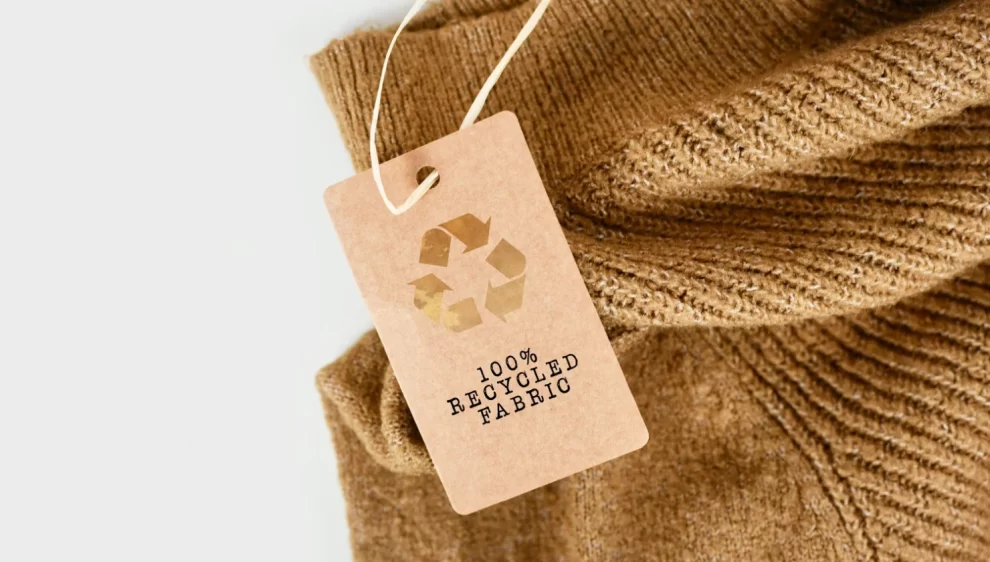To bolster their environmental reputation after their sustainability efforts have been deemed performative, many retailers are turning to AI.
The latest AI buzz in the world of fashion is its promise of solving the industry’s sustainability crisis.
Yet as brands’ finances are challenged by supply chain disruptions such as geopolitical tensions, port congestion, increasing freight prices and material scarcity, AI priorities lie far from saving the planet.
Sustainability: retailers’ greatest marketing ploy
As consumers begin to feel the heat of environmental anxiety, brands’ ears have pricked up to pounce on consumers’ latest interests. Aware of growing environmental consciousness among consumers, brands are turning their hands to popular strategies to retain profit and maintain a solid reputation.
Websites are awash with green marketing tactics, focused mainly on re-use and repair, recycling or the use of sustainable materials. M&S has partnered with Oxfam for its “Shwopping” scheme, where consumers can hand in clothes of any brand to be either donated or recycled. In Zara’s “Pre-Owned” section, customers can buy and sell old Zara products, and bring damaged items into a store to be repaired for a small fee. Uniqlo provides the same service, aiming to prolong the life of its products. Elsewhere, H&M hands repair responsibility over to consumers, selling “Care” products that include a lint roller and sewing kits, and eschewing responsibility by insisting that a “significant” share of a product’s emissions happen after it leaves the store.
H&M’s website provides tips on looking after clothes, including “How to remove coffee stains”. Buyers are humbly reminded that if only they had the insight to scrub the coffee from their favourite t-shirt, they may have prevented climate catastrophe. Yet while upcycling, incorporating recycled materials and resale platforms increase in popularity, so too do accusations of greenwashing. Buyers are struck by the realisation that brands’ priorities do not centre around helping their customers sew up an old jumper, but rather on the twin goals of profit and reputation.
AI goes green
To bolster their environmental reputation after their sustainability efforts have been deemed performative, many retailers are turning to AI. In 2023, Sainsbury’s teamed with Blue Yonder, using its products to predict consumer demand. This minimises both overstocking and understocking, preventing warehouse products from going to waste across their clothing, homeware and food brands. This sounds like a dream come true for the environment, brands and consumers, who are more interested than ever before in how they can enjoy fashion sustainably.
With overcoming inflation a priority for brands, AI is financially best served in tracking consumer interest to boost profits. Forever 21 and KIABI lost market shares between 2019 and 2022, and GlobalData analysts attribute this not to greenwashing scandals or sustainability concerns, but an inability to remain relevant and keep up with trends. Green AI strategies may be available, but are they truly brands’ priority?
Shein: tracking trends tops the market
For brands to master the market, they must focus on Gen Z, the generation with a pertinent interest in fashion and a penchant for spending over saving. According to GlobalData, only 23.5% of Gen Z cut back on spending in 2022 compared to 32.5% of consumers in older demographics. Brands must target Zs in their marketing while finding a way to stay on top of fast-moving trends. The success of using AI to keep hot on the heels of current trends is exemplified by Shein, the fast fashion giant and environmental supervillain that became the market leader in 2022 and recently acquired Forever 21. Shein’s agile supply chain allows it to propose thousands of new designs every day at affordable prices, with its AI model analysing trends daily.
Shein categorises trends on its website, currently catering not only to Cottagecore but to Dopamine Dressing and Y2K, as well as having a Pink Collection after the success of Barbie. Its AI model helps produce the “New In” section, which is updated daily and categorised by date. Hundreds of new products appear every day, daring consumers to be caught out on the ninth of September wearing something from the fifth. GlobalData predicts that the global market value will slow in 2023, so brands should follow Shein’s lead and prioritise tracking rapidly changing trends over sustainability pledges.
AI’s carbon footprint
Even if brands do adopt sustainable AI technology, it may not be as green as it seems. AI technology uses vast amounts of water and electricity to function. According to GlobalData, OpenAI’s GPT-3 emitted more than 500 metric tons of carbon dioxide during training.
While the material may not go to waste in warehouses, it inevitably will do so in consumers’ homes as brands tap into fast-moving trends. As TikTok’s “strawberry girl” aesthetic is eclipsed by “tomato girl”, another fruit no doubt waits in the wings, and another pair of cargo trousers heads to the bin. With consumers after affordability and the latest trends, and brands eager to overcome inflation issues and supply chain disruptors, Green AI is the latest sustainability fix that falls flat.
Source : Retail Insight Network






















